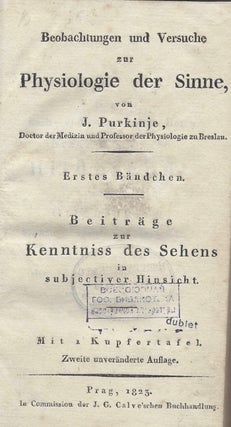Beobachtungen und Versuche zur Physiologie der Sinne von J. Purkinje, Doctor der Medizin und Professor der Physiologie zu Breslau. Erstes Bändchen. Beiträge zur Kenntniss des Sehens im subjectiver Hinsicht. Mit 1 Kupfertafel. Zweite unveränderte Auflage.
Prag: In commission der J. G. Calve’schen Buchhandlung [Johann Gottfried Calve], 1823. Second edition (identical to the first, only the title page changed). In contemporary hard paper. (11), 4–176, (1) p., and 1 folded, engraved plate. Traces of paper vignettes to spine. Binding slightly rubbed at extremities. Old collection stamps on title and some other pages. Water stain on second leaf. Otherwise clean. In fine condition.
Purkyně’s doctoral dissertation on inner vision, a milestone in experimental psychology.
This treatise, Purkyně’s doctoral dissertation, is an attempt to find the guiding rules of the inner visual impressions, the "subjective vision”. Purkyně sought to elucidate and quantify the so-called entropionic images, the images can be seen while eyes are closed and the eyelid is turned inward against the eyeball. His work is also known as the first report on the flicker-light induced patterns, the colour and form hallucinations that homogeneous flickering light could cause. Purkyně describes and classified the different patterns of “subjective vision” and shows these complex figures—coloured stars, spirals, tartans, squares, hexagons— on the appended folded plate.
Two issues are recorded of the 1819 first edition of the work, the first with title page gives the publisher as Fr. Vetterl and describes the author as "Candidaten der Medicin”, the second with errata, additional dedication, and altered title page, gives the publisher as Calve (just as this edition), and refers to Purkyně as "Doctor der Medicin”. This second edition was published with a cancel title (different title of the dissertation that suggest a subsequent volume, which appeared in 1825, different date, etc.) otherwise identical to the second issue of the 1819 edition, thus could be considered as the third issue.
Jan Evangelista Purkyně (1787–1869) was a Bohemian polymath, and pioneer of experimental physiology. He studied medicine and philosophy at the University of Prague where graduated in 1819. After he published his dissertation, this work, he was appointed as Professor of Psychology at the same institute. While at Prague, he discovered the phenomenon that as light intensity decreases, red objects are perceived to fade faster than blue objects of the same brightness, known as the Purkinje effect. In 1823 he developed a system of classification of fingerprints and defined nine recurring variations of patterns of fingertips. In the same year, he was offered the chair of physiology and pathology at the University of Breslau, where, in 1839 he set up the world’s first physiological institute, and later in 1842 the first official physiological laboratory.
Purkyně is best know for the cell named after him, a large nerve cells with many branching extensions found in the cortex of the cerebral cortex, and the Purkinje fibers the fibrous tissue that conducts the pacemaker stimulus along the inside walls of the ventricles to all parts of the heart. Besides these achievements, he is responsible for introducing plasma and protoplasm the scientific terms and various other discoveries.
Garrison-M. 1492; Kruta, p. 77; Waller 7668; Norman 1763; Hirschberg VI, 42. Hirsch-H. IV, 688; DSB XI, 214.
Bibl: Zielinki, S.: Deep Time of the Media. Toward an Archaeology of Hearing and Seeing by Technical Means. Cambridge, Mass.: MIT Press, 2006. pp. 193–203.; Allefeld, C. (et al.): Flicker-Light Induced Visual Percepts: Frequency Dependence and Specificity of Whole Percepts and Percept Features. In: Consciousness and Cognition, V20 N4 (December 2011): pp. 1344–1362.
.
Price: €4,000.00


